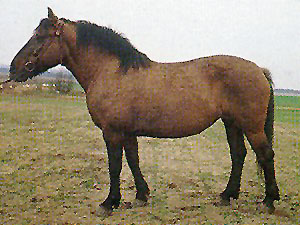
Viatka

Introduction: If you have any comments or suggestions, please click here.
Names: Viatka, Vyatka. I believe the latter is probably the more correct spelling but since Russian is in a different alphabet anyway, and I am more used to the former, I will probably use both for now. I will probably go back through later and change all the foreign names to their correct spellings. Maybe I'll have more than one spelling on the Search - Breeds page even!
Origin: The Vyatka belongs to the North Russian Pony group. Its development was strongly influenced by the natural conditions in the territories of what are now Kriov and western Perm regions and in Udmurtia. The Vyatka's formation was at different times influenced by native Estonian horses brought by Novgorod colonists in the 14th century and by edicts from the state horse breeders during the reign of Peter the Great. Subsequently, Estonian horses were imported during the development of the mining industry in the Urals. The valuable features of the Vyatka included good draft ability, such as sufficient speed, extraordinary endurance and good fodder utilization. It was often exported beyond the limits of the Vyatka province. By the first half of the 19th century it became the best troika horse in Russia.
Breeding: With
the development of industry and transportation and with the intensification of
agriculture, the numbers of the Vyaka were sharply reduced; most of the purebred
mares were mated with heavy draughters and trotters. The 1980 horse breeding
survey in Udmurtia and the Kirov region showed that the total number of horses
classified as Vyatka was about 2000. No stud breeds the Vyatka, and it needs
protection.
A Russian breed derived from the Baltic pony known as the
Klepper, crossed with the Finnish horse. Two slightly smaller strains,
known as Obvinkas and Kazankas, respectively, each average about 52 inches in
height.
Description: It resembles the Polish Konik and bears traces of old Klepper blood.
Body: Wide and deep. Back is broad, long, and sometimes slightly dipped at the withers. Croup is wide and on the short side. Withers are average in size.
Color: A characteristic feature of the breed is its chestnut-roan or bay-roan color with black stripe along the spine and wing-shaped pattern over the shoulders, as well as zebra stripes on the forelegs. However, the color can also be brown, bay, chestnut or rarely, black. Bay, grey, roan, or mouse-dun.
Hair: The forelock, mane, and tail are thick and long.
Head: Clean-cut with a wide forehead and broad jaws.
Legs: Short and solid with good hoofs, but the hind legs are often sickle-hocked.
Neck: Short and fleshy, but often well-arched.
Size: 13 to 14 hands high; more detailed measurements
below.
The average measurements (in centimeters) of modern Vyatka mares are: height at withers
140, oblique body length 150, chest girth 172, and cannon bone girth 18.9. The
live weight is 400 kg. 52-56 inches.
Temperament:
Features: The strong Viatka is particularly well known for its hardiness and good
speed. In the long term, the
breed could become quite competitive due to the development of tourism. As
draught horses, the crosses of the Vyatka and heavy draughters are quite strong,
have good fodder utilization and practically no reaction to midges and
blood-sucking insects.
In the wintertime these ponies develop a heavy coat of woolly
hair, along with a thick layer of subcutaneous fat, as a protection against the
intense cold.
Uses:
Accomplishments:
Curiosities:
Profiles:
Conclusion: